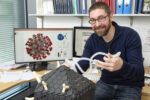

TRIM21 is the cytosolic E3 ligase and antibody receptor responsible for intracellular antibody immunity. Unlike other ubiquitin ligases, TRIM21 doesn’t have a defined substrate but is directed towards its targets by antibodies. This unusual mechanism allows TRIM21 to target highly diverse substrates from bacteria and viruses to neurodegenerative aggregates and protein complexes. This diverse activity allows TRIM21 to prevent fatal viral infection or inhibit the accumulation of tau aggregates. Our mechanistic understanding of TRIM21 has allowed us to develop useful technologies like Trim-Away, a method for the targeted degradation of proteins, but many key questions remain as to how TRIM21 is activated and regulated.
The canonical view of ubiquitination is that E3s determine chain specificity by recruiting specific E2s. Chain specificity in turn is thought to determine the choice of degradation pathway – typically K48 linkages for the proteasome and K63 for autophagy. However, TRIM21 can recruit and utilize a range of E2s and direct substrates to both the proteasome and autophagy. How TRIM21 accomplishes this feat, how these activities are regulated and whether this explains its ability to degrade diverse substrates is unknown.
We are looking for a talented PhD student to join our team and help provide an answer to these questions. You will be a highly motivated and dedicated researcher with a desire to understand biology at the molecular and cellular level and a willingness to learn whatever technique is needed to do so. We offer the opportunity to work alongside like-minded individuals from a variety of backgrounds and develop your own project whilst contributing to the projects of others. Within the group and across the LMB we offer training in a wide-variety of techniques, from structural/biophysical approaches to cellular and animal models of infection.
References
Kiss, L., Rhinesmith, T., Luptak, J., Dickson, C.F., Weidenhausen, J., Smyly, S., Yang, J., Maslen, S.L., Sinning, I., Neuhaus, D., Clift, D., James, L.C. (2023)
Trim-Away ubiquitinates and degrades lysine-less and N-terminally acetylated substrates
Nat Commun 14(1): 2160
Mukadam, A.S., Miller, L.V.C., Smith, A.E., Vaysburd, M., Sakya, S.A., Sanford, S., Keeling, S., Tuck, B.J., Katsinelos, T., Green, C., Skov, L., Kaalund, S.S., Foss, S., Mayes, K., O'Connell, K., Wing, M., Knox, C., Banbury, J., Avezov, E., Rowe, J.B., Goedert, M., Andersen, J.T., James, L.C., McEwan, W.A. (2023)
Cytosolic antibody receptor TRIM21 is required for effective tau immunotherapy in mouse models
Science 379(6639): 1336-1341
Zeng, J., Santos, A.F., Mukadam, A.S., Osswald, M., Jacques, D.A., Dickson, C.F., McLaughlin, S.H., Johnson, C.M., Kiss, L., Luptak, J., Renner, N., Vaysburd, M., McEwan, W.A., Morais-de-Sá, E., Clift, D., James, L.C. (2021)
Target-induced clustering activates Trim-Away of pathogens and proteins
Nat Struct Mol Biol 28(3): 278-289
Caddy, S.L., Vaysburd, M., Papa, G., Wing, M., O'Connell, K., Stoycheva, D., Foss, S., Andersen, J.T., Oxenius, A., James, L.C. (2021)
Viral nucleoprotein antibodies activate TRIM21 and induce T cell immunity
EMBO J 40(5): e106228
Clift, D., McEwan, W.A., Labzin, L.I., Konieczny, V., Mogessie, B., James, L.C., Schuh, M. (2017)
A Method for the Acute and Rapid Degradation of Endogenous Proteins
Cell 171(7): 1692-1706